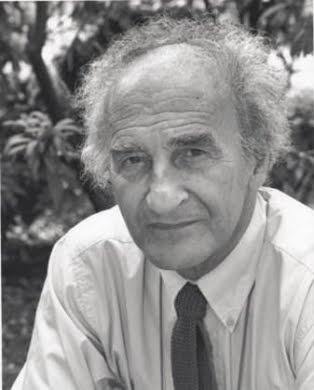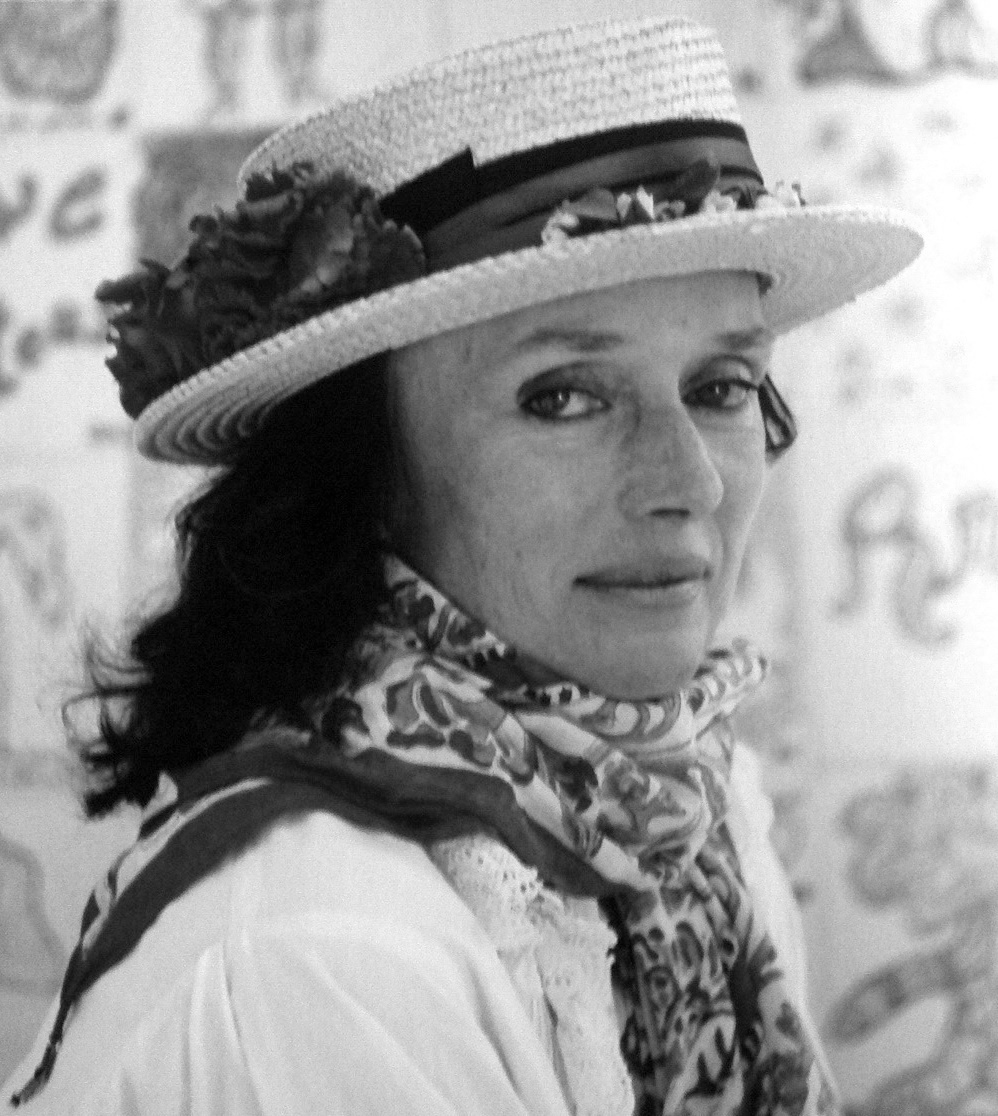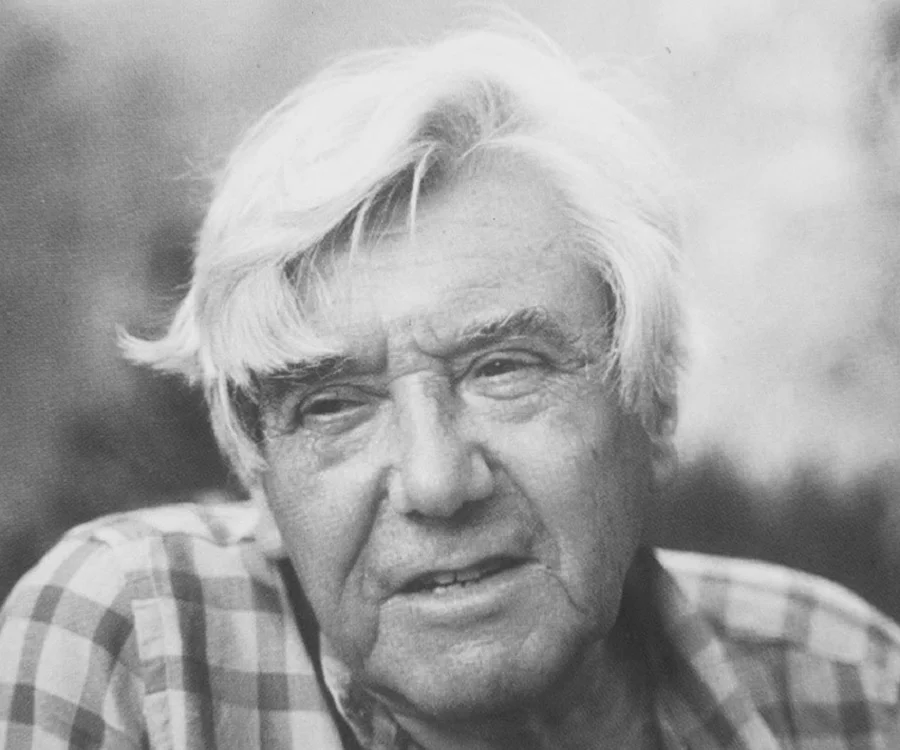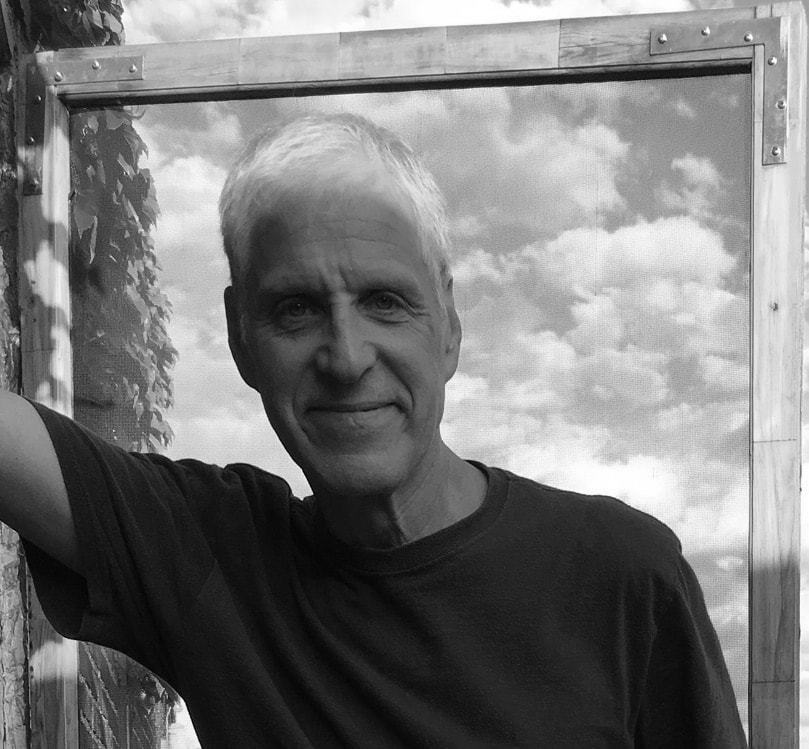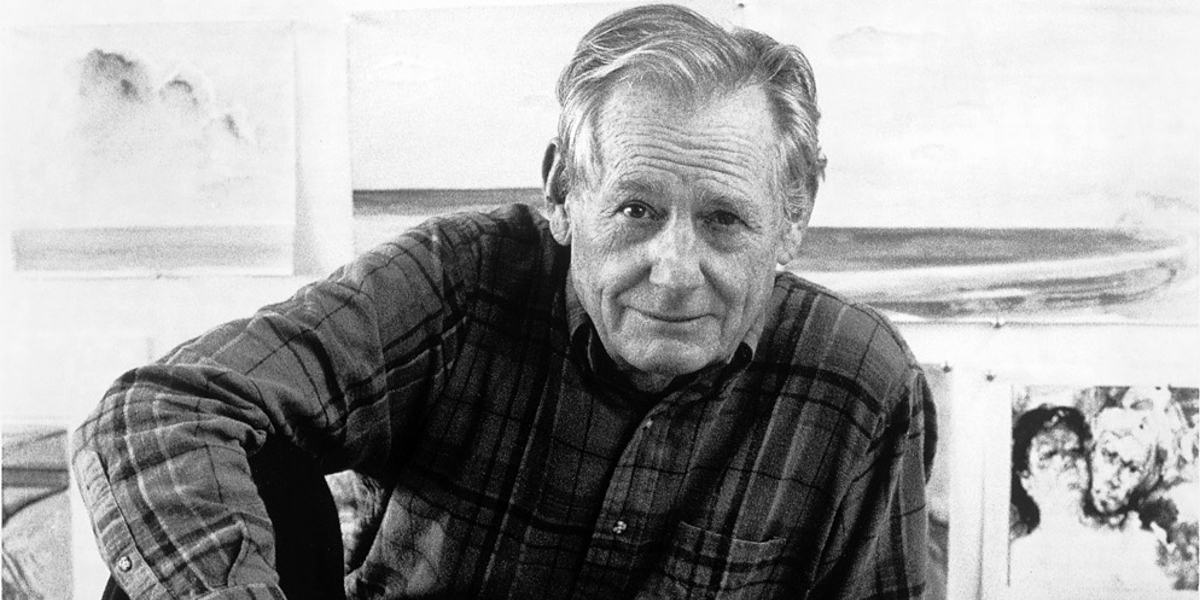Fletcher Benton
“I could be dealing with sculpture in such a heavy way that it could create a great sort of mystery, and people could stand there and look at it and write into it whatever they needed to get out of it. I'm not that way. {What} I am working toward, I suppose, if we must speak the truth, is the child in every person. A certain innocence, and a certain classical sense of order.” - Fletcher Benton
Born in Jackson, Ohio, 1931, Benton earned his BFA at Miami University, in Oxford, Ohio, 1956. He arrived to San Francisco in the midst of the Beat Movement and Benton’s early paintings are noticeably inspired by this artistic and social mileu. He worked as a sign painter, which provided him with a familiarity of the alphabetical shapes which arise in his later work. Rather than working from sketches or drawings, Benton creates a series of maquettes to explore the geometry and visual power of the composition in steel. Balance, perception, kinetic energy and movement all inspire Benton’s various series utilizing rods, balls, sheets, boxes and edges of metal. Benton taught at San Francisco Art Institute from 1966 to 1967, when he left to teach at California State University, San Jose, where he stayed until 1986. He is the recipient of many awards and honors including The Liftetime Achievement in Contemporary Sculpture Award from the International Sculpture Center in New Jersey in 2008. Fletcher Benton passed away on June 26, 2019.
*1989 Interview with Archives of American Art
Fernando Botero
“I create my subjects somehow visualizing them in my style. I start as a poet, put the colors and composition down on canvas as a painter, but finish my work as a sculptor taking delight in caressing the forms.” - Fernando Botero
Born April 19, 1932 in Medellin, Antioquia, Colombia. At the age of 12 he is sent to a school of Tauromachy to study bullfighting. In 1949, he worked as an illustrator for the local newspaper and around this time, he encountered the work of Picasso in a book by Argentinean art critic Julio Payro. Botero was expelled from school after publishing an article entitled “Picasso and Nonconformity in Art.” He worked as a set designer for a traveling Spanish theatre company in the early 1950s and moved to Bogotá, where he befriended members of the avant-garde circle, including writer Jorge Zalamea. After traveling through Spain, he enrolled at the Academia San Fernando in Madrid, and encountered the works of Goya and Velasquez in the Prado, 1952. During this time, he supplemented his income by painting copies of the masters. Botero traveled to Paris and then Florence, where he attended the Academia San Marco and studied the Italian Renaissance Masters, 1952-1954. Returning to Bogotá briefly, he moved to Mexico City, 1955-1956. He illustrated Gabriel Garcia Marquez’s Chronicle of a Death Foretold, which appeared in Vanity Fair. He established a workshop in Tuscany, where he would spend a few months a year working on sculpture. Botero died in Monte Carlo, where he had lived the past couple of decades, September of 2023.
Lynn Chadwick
“Apart from these practical considerations [i.e. the possibilities and limitations of welded iron] I do not analyze my work intellectually. When I start to work, I wait till I feel what I want to do; and I know how I am working by the presence or lack of a rhythmic impulse. I think that to attempt to analyze the ability to draw ideas from their subconscious source would almost certainly interfere with that ability.” - Lynn Chadwick
Lynn Chadwick was born in London in 1914 and educated at the Merchant Taylor’s School. As a young man he worked as an architectural draftsman for several London architects. During WWII he served as a pilot in the Royal Navy’s Fleet Air Arm. After the war he returned to the Rodney Thomas architectural firm and designed and constructed trade fair presentations. He also produced textile, furniture and architectural designs beginning in 1947. This same year, encouraged by Thomas, Chadwick constructed his first dynamic mobile sculptures. In 1951 the artist received his first solo exhibit at Gimpel Fils featuring mobile sculptures and was commissioned to create three works for The Festival of Britain as well as invited to exhibit with the American Abstract Artists Group in New York. His reputation grew when he exhibited with seven other British sculptors in the British Pavilion at the 1952 Venice Biennale and again in 1956 when he was chosen to represent England at this Biennale, winning the International Prize for Sculpture. Chadwick’s expressionistic figures, constructed in welded iron and bronze, captured the anxious mood of post war society. His lonely creatures inhabited pleated, angular shapes while capturing human/animal postures balancing on precariously thin legs. In the 1960’s the artist’s interest developed to include pairs or groups of figures which he would eventually clothe, sometimes in regal attire. Chadwick continued his gestural exploration by placing his figures in diverse positions including dance, ascending stairs and encountering the wind. Lynn Chadwick died in November of 2003 and was laid to rest on his Lypiatt Park estate.
*The New Decade: 22 European Painters and Sculptors, Museum of Modern Art exhibition catalogue, New York, 1955, p. 71.
Melissa Chandon
“.. a couple of years ago, I had a major shift in vision, a desire to paint pictures that encourages people to think about where we come from. I wanted to document the 30’s, 40’s, 50’s and 60’s in a way that made people want to think about what we’re doing now, what we’re building.” - Melissa Chandon
Melissa Chandon was born in Biloxi, Mississippi in 1952. She received a BFA from Santa Clara University in California with an emphasis in painting and philosophy. Her MFA was received from Lesley University College of Art and Design, Cambridge, Massachusetts. Chandon has devoted herself full time to painting since 1996. She began teaching at UC Davis in 2009 and since 2013 has taught Design there. In addition, Chandon has taught numerous plein-air workshops in the U.S., France and Mexico.
Chandon is a classically trained artist who describes her work as abstract realism. It is through analysis and redaction that she finds her voice. Her work is autobiographical, kindled by childhood travels with her family throughout the United States and allows Chandon to make connections between the present and recent past. “Road trips were my parents’ passion. They saw the American landscape as a means of educating their five children – exposing us to the humanity of highways, small towns, truck stops and KOA Kampgrounds all across the U.S. To this day I find cars, gas stations, motels, billboard signs fascinating –and I feel it is important to document this era of American history before it disappears.”
Melissa Chandon has been influenced by several artists including David Hockney, Edward Hopper, Richard Deibenkorn and Wayne Thiebaud. Thiebaud was also a most valuable mentor and encouraged her to push forward with examination and determination. Thiebaud said of Chandon’s work: “She has developed an effective synthesis of abstract and representational elements in her works. This gives the works an intensity and raw graphic power to behold.”
Chandon has exhibited extensively in museums and galleries throughout California and the Southwest. Her paintings are found in public, private and corporate collections including the Fine Arts Museum of San Francisco, the Napa Valley Museum of Art, the Triton Museum of Art, and the private collections of Queen Raina Al Abdullah of Jordan and Al Gore.
Eduardo Chillida
"The desire to experiment, to know, often forces me to lead my work along an interrupted itinerary, since experimentation interests me more than experience. I also prefer knowing to knowledge." - Eduardo Chillida
Born January 10, 1924 in Donostia (San Sebastian) in the Gipuzkoa Providence of the Basque Country, he studied architecture in Madrid for four years, but never completed his training. In 1947, Chillida enrolled in a private school in Madrid to study drawing and experiment with sculpting. Although he sojourned to France, where he began his lifelong friendship with artist Pablo Palazuelo, he returned to his native home of Donostia to live and work. Chillida experimented with various forms of clay and plaster, and exhibited his first two sculptural works at the Salon de Mai in Paris, 1950. A series of large commission pieces earned him recognition worldwide. By 1960, his work was included in the exhibition "New Spanish Painting and Sculpture" at the Museum of Modern Art, New York. His wood, iron, granite, gypsum and alabaster works are recognized by critics for the innovative use of positive and negative space. Chillida passed away on August 19, 2002.
Jose Luis Cuevas
"It is a commonplace world which I have depicted, not in the petty details of daily existence, but in its essence. It is not my intention either to condemn or to justify it. I seek merely to describe it in the terms of my own sensibility, without imbuing it with any message whatsoever." - Jose Luis Cuevas
Born in a paper factory in Mexico City, February 26, 1934. Cuevas studied at the School of Painting and Sculpture in La Esmeralda, Mexico City from 1944-1947 and studied engraving with Lolo Cueto at Mexico City College, 1948. In 1954 he met critic Jose Gomez Sicre, who invited him to exhibit in the Pan-American Union, Washington, D.C. He was Professor of Drawing at Latin American University, Mexico City from 1956-1957 and worked briefly at Philadelphia Museum School of Art, San Jose State College and Fullerton College. In 1965, Cuevas met longtime friend and collaborator Jose Tasende in Mexico City. The artist's work echoes his cultural heritage of Mexico especially the Day of the Dead, a celebration of death and life. However, he has always demonstrated a fervent appreciation of traditional European values. Jose Luis Cuevas died July 3, 2017 in Mexico City.
Niki de Saint Phalle
“I’m following a course that was chosen for me, following a pressing need to show that a woman can work on a monumental scale.”
“My mental breakdown was good in the long run, because I left the clinic a painter.” - Niki de Saint Phalle
Niki de Saint Phalle was born on October 29, 1930 in Neuilly-sur-Seine, France, into an aristocratic family. At a young age the family relocated to New York and Niki attended the Convent School of the Sacred Heart in New York as well as Brearley and graduated from Oldfield, a boarding school near Baltimore. She married Harry Matthews, the writer, in 1949 and their first child Laura was born in 1951. Their son Philipe was born in 1955. The young family lived in many European cities and towns. Niki discovered painting and the direction for her life while recovering in Nice from a nervous break down. She created her first oils and gouaches in 1953. While visiting Barcelona in 1955, she was deeply impacted by the architecture of Antoni Gaudí, especially his Güell Park which inspired ideas of one day making her own sculpture park. In 1960 she conducted her first experimental rifle-shot painting and began a long and productive collaboration with Swiss sculptor and future husband, Jean Tinguely. She joined the New Realists group and exhibited her work for the first time in 1961. Collaborations with Tinguely include Hon and Le Parqadis Fantaqstique both from 1966 and in the collection of the Moderna Museet in Stockholm. Another large collaborative installation with Tinguely was the Stravinsky Fountain, 1983, installed beside the Centre Pompidou in Paris. In the late 1970’s the artist began what she considered to be her life’s work, The Tarot Garden. Located on a 14-acre site in Tuscany, the garden represents 22 figures of the Tarot’s major arcana. Fundraising efforts for the garden included Saint-Phalle creating a self-named fragrance for Jacqueline Cochran Company. The documentary film on the artist Who is the Monster, You or Me? was made in 1995 by Peter Schamoni. Toxic fumes from materials used in her earlier sculptures including polyester caused severe damage to the artist’s lungs and initiated a move to La Jolla, California in the mid 1990’s. One of her last major projects was Queen Califia’s Magical Circle sculpture park created on a 12-acre parcel in Escondido, California. The installation includes a maze entrance, a 400-foot circular “snake wall’ which encompasses eight totem sculptures ranging in size from 11 to 21 feet high and adorned with mythical creatures and animals derived from Native American, Pre-Columbian and Mexican art as well as the vibrant imagination of the artist. The totems encircle Queen Califia, the mythical warrior founder of California. This park represents the artist’s late period mosaic work. Niki de Saint Phalle passed away May 21, 2002 in La Jolla, California.
Mark di Suvero
“Space has been the most important element in sculpture for me. We see space stereoscopically (with two eyes) yet almost all photographs see monocularly (with one eye). To replace this lost dimension, I have thought to add poems I love and that have changed my life, so that the bridge between the poem and the photo-image becomes the true reality, a voyage to the imagination in your mind’s eye.” - Mark di Suvero
Born to Italian Diplomats in Shanghai, China, September 18, 1933, di Suvero and his family immigrated to San Francisco in 1941. He dropped out of high school to travel, and eventually apprenticed as a ship builder and house painter. From 1953 to 1956 he jumped from school to school, studying sculpture and philosophy at San Francisco City College, the University of California Santa Barbara and University of California, Berkeley, where he graduated with a B.A. in Philosophy. In 1957 he moved to New York where he began sculpting with scrap material. In 1960 di Suvero was paralyzed by a fall down an elevator shaft. He built the “Tower of Peace” in 1966 as a protest against the Vietnam War in Los Angeles, California and established the Socrates Sculpture Park, an outdoor museum and artist residency program in Long Island, NY, 1986. Di Suvero’s work is a fusion between 1950’s Abstract Expressionism painting and 1960’s constructivist sculpture; his work maintains the fluidity of the first and the assemblage of the latter.
Giacomo Manzù
“The concept of a sculpture must not emanate from your bourgeois prejudices but only and exclusively from love. It is not only to you I say this: I constantly impress it upon myself as well.” - Giacomo Manzù
Born December 22, 1908, in Bergamo Italy, the twelfth child of a poor cobbler and sacristan. Although he was mainly self-taught in art, he began his career as a draughtsman and sculptor, after he received experience as an apprentice of woodcarving and eighteen months of military training in Verona. Influenced by the Etruscans, Roman and Gothic stonemasons, and Medardo Rosso, Manzù used his reactions to Parisian Impressionism to infuse his own work with light and materiality. He taught at the Turin Academy during the war years and in 1942 he established a studio near Milan, where he began working with genre subjects. The unlikely pair of Pope John XXIII, fellow citizen of Bergamo, and Manzù, Communist sculptor, created a warm and significant friendship which resulted in many beautiful works of art. Pope John commissioned several important works, including his portrait bust and perhaps Manzù’s most important work, the portal of St. Peter’s Cathedral in Rome- the first new doors in the cathedral for 500 years. Manzù passed away January 17, 1991.
*Excerpt from a speech given to his students at the conclusion of his lectureship in Salzberg, 1960.
Roberto Matta
“I am interested only in the unknown and I work from my own astonishment.” - Roberto Matta
Born November 11, 1911 in Santiago, Chile to Basque parents. He received his diploma in Architecture in 1931, after studying at Catholic University in Santiago for three years. From 1928 to 1936, Matta worked all over Europe as a merchant seaman, interior decorator and architectural assistant, including as a draughtsman for Le Corbusier. Matta was mostly self-taught in painting and worked as an independent painter in Paris, New York, Rome and Paris until 1955. He met playwright Federico Garcia Lorca in Spain, who introduced him to Salvador Dali, who in turn introduced him to the artist Andre Breton, 1934. With his “inscapes” and “psychological morphologies” he joined the Surrealist group, 1937-48 and moved with many of them from Paris to New York during WWII. His Surrealist paintings greatly influenced American Abstract Expressionism. Expelled from the Surrealists, he returns to Europe in 1949 and eventually becomes a French citizen. He founded the Etrusculudens, an Etruscan crafts artisan group, and presided over the Cultural Congress in Havana in 1966. Matta passed away November 23, 2002 in Civitavecchia, Italy.
Henry Moore
“The secret of life is to have a task, something you devote your entire life to, something you bring everything to, every minute of the day for the rest of your life. And the most important thing is, it must be something you cannot possibly do.” - Henry Moore
Born July 30, 1898 in Castleford, Yorkshire, Moore began his studies in teaching, 1915. After serving as Lance-Corporal and an official war artist in the army during the First World War, Moore went to Leeds School of Art for two years. In 1921 he was granted a scholarship to attend Royal College of Art until 1925, when he traveled to Italy and France. Around this time, he became interested in the Mayan, Egyptian and African sculpture he saw at the British Museum and during his travels. Moore was highly influenced by the Mexican pre-Columbian work in the Aztec Chacmool, and used these references in his first Mother and Child sculptures, 1922. Moore worked at the Royal College of Art, and later moved to Chelsea School of Art as the Founder of Department of Sculpture, until 1939. He became a member of Unit One, a group of artists organized by Paul Nash in the 1930’s. In the 1950’s Moore worked mostly with bronze, creating “Internal and External Forms,” which echo the relationship between man and woman or mother and child. In the 1960’s he produced his most abstracted work, inspired by the art of Brancusi. Moore passed away August 31, 1986 in Much Hadham, Hertfordshire.
Andres Nagel
“Que horror, que horror. Faster Pussycat, Kill Kill.” - Andres Nagel
Born in San Sebastian on August 15, 1947, Nagel began his studies in architecture. In 1965 Nagel attended University of Navarre, Pamplona, finishing his degree in Architecture in 1972. He first exhibited his work, mostly sculpture of fiberglass and polyester, in his native city in 1968. During this time, Nagel also traveled throughout Europe and worked on engraving with Grupo 15 in Madrid, where he met an influential artist and friend, Eduardo Chillida. In 1974, he opened his first exhibition in Madrid, at Galería Iolas Velasco, and then in Bilbao, at Galería Luzaro. After traveling through northern Africa and Southeast Asia, he joined architects Cristina Fontan and Angel de la Hoz on a Greyhound bus to travel throughout the United States and Canada on a several month excursion, 1983. During 1985, Nagel taught a one-month seminar at the Circulo de Bellas Artes of Madrid and Jose Julian Baquedano made a short film focused on his work. In addition to countless other exhibitions presenting his work, the Museo de Bellas Artes in Bilbao held a retrospective show of Nagel’s work in 1995. In 1997 he exhibited at Tasende Gallery’s new space in West Hollywood, for which he designed the entrance door.
Louise Nevelson
“You must create your own world. I’m responsible for my world ... I just feel that I’m in turn with the right vibrations in the universe when I’m in the process of working.” - Louise Nevelson
Born on September 23, 1900 in Kiev, Russia, Louise Berliawsky and her family immigrated to the United States in 1905. She married Charles Nevelson, a wealthy ship owner and enrolled in the Arts Students League where she studied voice, dance and painting in 1920. During the 1930’s she studied art with Hans Hoffman in Munich. Nevelson worked as a film extra in Berlin and Vienna, 1931, and as an assistant to Diego Rivera on the Rockefeller Center murals, 1937. She turned her efforts to teaching in New York throughout the 1950’s, working as an Instructor of Art at Educational Alliance School and Great Neck Adult Education Program. In 1952, Nevelson traveled to Mexico to pursue her interest in archaeology, and during this time she began producing her signature black wood landscape sculptures. Nevelson passed away April 17, 1988 in New York.
Josep Riera i Arago
“It is in the everyday act of drawing, of inscribing my thoughts, where the vital instants come and my hand becomes so much more than a mere instrument of my mind.” - Joseph Riera i Aragó
Born June 28, 1954 in Barcelona, Spain, he attended Barcelona University, 1972, and Sant Jordi Fine Arts School, 1973. He began his career painting landscapes in oil, while living on the isolated Cabrera Island, 1975-76. While he lived and worked in Granada, Riera i Aragó discovered his interest in astronomy, befriended several scientists at the Andalusia Institute of Astrophysics, and frequented the Sierra Nevada observatory. While visiting Paris in 1978 he experienced the art of Paul Klee and Joan Miró. Throughout the late 1970’s and 1980’s, Riera i Aragó traveled through Spain and Morocco, collecting artifacts and archetypal objects to inspire his work. These adventures led him to Japan, 1991, where he developed a great interest in the ancient temples of Kansai.
Armando Romero
“Art comes from art. There are no ideas or objects that have not been appropriated." When I paint, I replicate at the same time because everything that I see and everything that I could think already exists. What is important is the originality with which I see, think and emulate. To see that which is visible as something never seen before and see the never seen before as something already seen.” - Armando Romero
Born in Mexico City in 1964. Romero studied sculpture at the “La Esmeralda” National School of Painting, Sculpture and Graphics in Mexico City. After graduating, he taught Sculpture, Painting and Art History at “La Esmeralda” from 1991 to 1997. Additionally, he taught Art History, Design, and Drawing at the College Center for Studies in Science and Communications from 1991 to 1993, and Painting at the School for Visual Arts in Michoacán, Mexico in 2002. In 1998 Romero was selected to represent Mexico in the Emerging Artists of Latin America exhibition at the L’Espace Passage de Retz in Paris, France. In 2001 he lectured on sculpture and participated in the International Studio Program of the National Foundation for the Arts in the United States.
Jonathan Seliger
“In my work, I try to blur the boundary between painting and sculpture in order to create what can be regarded as a three-dimensional painting. Drawing on the languages of Pop and Minimalism, abstraction and representation, I make recognizable objects, such as milk containers, shopping bags, or matchbooks, using traditional painting and printing materials and techniques. By focusing on mundane, ephemeral, or disposable subjects, I want my work to be both ordinary and poetic, accessible and transfigured.” - Jonathan Seliger
Jonathan Seliger, born 1955 New York, studied English and Comparative Literature at the State University of New York, Binghamton. He has worked as an art critic, art journal editor, curator and gallery director before transitioning to painting in 1990. Seliger began by creating small scale dimensional representations of common, everyday objects such as matchbooks, envelopes, milk cartons. The artist was responding to the objects’ specificity, worldliness and transitory value.
The artist is known for his meticulous execution and his play with scale. Intriguing titles add a dimension of humor and critique to the work. Seliger’s luxury shopping bag series which he began in 2000 exemplifies these qualities. “I like the way they (shopping bags) evoke transportedness, carrying something from one place to another – a resting point between destinations. In this case what they carry is not fixed or solid, but constantly shifting: they convey meaning. What they hold is not ”inside, it’s all on the surface.” Further, he said, “….these pieces are meant to be seductive, beautiful – a celebration and a critique.”*
Seliger has been widely exhibited in museums and galleries throughout the U.S., Europe and Japan. The artist lives and works in Brooklyn, New York.
*Interview with Ian Berry reproduced in the exhibition catalogue for Jonathan Seliger Floor Model, The Tang Teaching Museum and Art Gallery, Skidmore College, Saratoga Springs, New York, 2001.
Wayne Thiebaud
“Reduction in a realist painting is the same as reducing a sauce. You take away by simplification, by leaving out details. But you also put in selective bits of other experiences, or perceptual nuances which enforce it, giving it more of a multi-dimension than if it were done directly as a visual recording.” - Wayne Thiebaud
Born in Mesa, Arizona, November 15, 1920, Thiebaud’s family moved to Los Angeles in 1921. In high school he became interested in stage design and lighting, and worked part-time at a movie theater where he made posters for lobby displays, 1935-1938. During this time he also worked as a summer apprentice in the animation department of Walt Disney Studios, 1936. From 1942 to 1945, Thiebaud served in the Air Force, assigned to the Special Services Department as an artist and cartoonist, and eventually transferred to the First Air Force Motion Picture Unit, commanded by Ronald Reagan. He studied at San Jose State College and Sacramento State College, California where he received his B.A., 1951, and M.A., 1952.
Thiebaud subsequently began teaching at Sacramento City College. In 1960, he became assistant professor at the University of California, Davis, where he remained through 1991, influencing numerous art students. He held a Professor Emeritus title there up until his death in late 2021.
He was associated with the Pop art painters because of his interest in objects of mass culture; however, his works, executed during the 1950s and 1960s, slightly predate the works of the classic pop artists, suggesting that Thiebaud may have had an influence on the movement. Thiebaud employed heavy pigment and exaggerated colors to depict his subjects, and the well-defined shadows characteristic of advertisements are almost always included in his work. Thiebaud was averse to labels such as "fine art" versus "commercial art" and described himself as "just an old-fashioned painter". He disliked Andy Warhol's "flat" and "mechanical" paintings and did not consider himself a pop artist.
In addition to pastries, Thiebaud painted characters such as Mickey Mouse as well as landscapes, streetscapes, and cityscapes, which were influenced by the work of Richard Diebenkorn. His paintings have been compared to Edward Hopper's work, another artist who was fascinated with mundane scenes from everyday American life.
Thiebaud was inducted into the California Hall of Fame in 2010 at the California Museum, Sacramento, and in 2013, he was honored with the California Art Award in recognition of his part in raising the prominence of California art around the world.
He died at his residence in Sacramento on Christmas Day 2021, at the age of 101.
Lambert Maria Wintersberger
"I can only rely on my own means, trust that my colors create something that - first - surprises me and - second - is still true and then, stands against everything else." - Lambert Maria Wintersberger
This quotation by iconoclast German neo-expressionist Lambert Maria Wintersberger accurately describes the essential character of an oeuvre which has committed itself to uncompromising authenticity and originality. In his often mystic-narrative paintings Wintersberger concentrates on the depiction of aspects most impressive to him, thereby constructing timeless settings of elements taken from different cultures and ages emanating from his “fury of association” as he once put it.
Born 1941 in Munich, Germany, Wintersberger studied at the Academy of Fine Arts in Florence, Italy from 1961 to 1964. Beginning in the early 1960’s, he worked as an independent artist and was associated with Germany’s “Neue Wilde” painters, which included such artists as Baselitz, Penck, and Hödicke. From 1974 to 1979, he taught at the Academy of Art in Düsseldorf. He exhibited extensively throughout his native Germany and Europe, including the Ulmer Museum, the Museum of Modern Art in Paris, and the Leoppold-Hoesch-Museum in Düren. In 1987 he spent a year living and working at an artist’s colony in Omaha, Nebraska. Wintersberger and his wife Dolores lived in Alsace, France for many years. The artist died in 2013.




